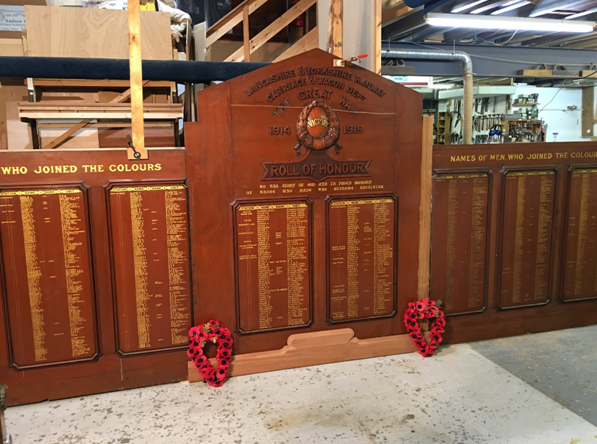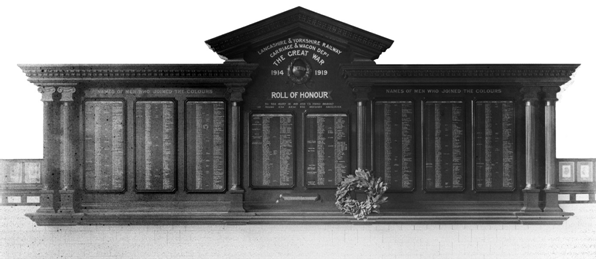Armistice Day tribute sees ‘lost’ memorial displayed
 During the lead up to Armistice Day thoughts were focused on the centenary of the end of hostilities in the First World War.
During the lead up to Armistice Day thoughts were focused on the centenary of the end of hostilities in the First World War.
At furniture restorers Andrew G Podmore & Son in York restoration work is progressing well on the memorial for members of the Lancashire and Yorkshire Railway who lost their lives in the conflict.
At the outbreak of war in 1914 the company had a 37,000 strong workforce. Over 10,000 would volunteer for the armed forces and 1,422 would lose their lives.
After the war the workers at the L&YR’s carriage and wagon department decided to create a war memorial and immortalise their 117 fallen comrades, as well as recording the names of all those in the department who served.
Made of solid teak the 8.5m-long Palladian-style memorial, with its pillars, pediments and entablatures, was erected in the company’s Newton Heath Carriage Works, where most of men had worked.
When the carriage works closed in 1928 the memorial was re-erected in Newton Heath Town hall. Alas, following the closure of the town hall itself, it disappeared from record until the 1990s, when it was found in the undercroft at Manchester Piccadilly station by British Rail staff who were clearing the site for re-development.
Although most of the memorial's structure was lost the eight panels of names had survived, although damaged. Fortunately, its historic value was recognised and BR’s area civil engineer arranged for the remains of the memorial to be taken for storage to the workshop of the East Lancashire Railway – an enthusiast-run tourist line based in Bury – where they remained for over 20 years.
With the centenary of the Armistice approaching, the ELR – recognising that it had neither the resources to restore the memorial nor the space to display it – approached the Railway Heritage Trust to see if it could help. The RHT agreed to help and to fund the restoration. It asked Andrew G Podmore & Son of York to reassemble the panels with a view to eventually restoring it and returning it to as near to its original home as possible. Northern Rail rapidly agreed to re-erect the memorial in its depot at Newton heath, near the site of the original works.
 David Podmore was tasked with establishing how the memorial was constructed. He and colleagues quickly recognised that a great deal of architectural detail was missing: evidence of cornicing and possibly columns could be detected in the shadows of the panels; however, no photographic or drawn records appeared to exist to quantify the findings. It was with great good fortune that Andy Savage of the Railway Heritage Trust tracked down one image and found the original glass plate slide, in the archive of the National Railway Museum at York.
David Podmore was tasked with establishing how the memorial was constructed. He and colleagues quickly recognised that a great deal of architectural detail was missing: evidence of cornicing and possibly columns could be detected in the shadows of the panels; however, no photographic or drawn records appeared to exist to quantify the findings. It was with great good fortune that Andy Savage of the Railway Heritage Trust tracked down one image and found the original glass plate slide, in the archive of the National Railway Museum at York.
That single image proved extremely valuable in the research of the piece and, as predicated, it clearly shows six Ionic columns and a heavy Palladian cornice and base mouldings.
With much of the damage to the original entablature panels now repaired and some of the new moulding sections reconstructed, David Podmore thought it fitting that the memorial should be temporarily erected in the workshop over the weekend of Armistice Day, to honour the men whose names are recorded. Traditional poppy wreaths were put in place and the workshop was silent on the 11th.
Apart from the significant record the memorial represents, it also provides a valuable genealogical reference that had been unseen for many years. Interestingly, apart from the names of the service personnel, it records which station or depot they were from, the regiment they joined and the rank they achieved. Northern Rail has receiving numerous enquiries from regimental associations seeking to record service details and hopes to contact relatives of those named on the memorial.
The re-dedication and unveiling of the restored Lancashire & Yorkshire Railway Carriage & Wagon Department First World War Memorial to those who fell or served in the Great War took place on Friday 28 June 2019.
In the 1990’s the name boards from the memorial were brought to the ELR for safe custody and remained in Baron Street for over 20 years. Works to restore the memorial to its original condition were undertaken by Andrew G Podmore & Son of York and the memorial is now located in the Northern Rail Newton Heath Depot.
The updated story of this remarkable rescue and restoration will be posted to our website and an edited version carried in the next edition of Ecclesiastical & Heritage World.
For further information visit www.agpodmore.co.uk













